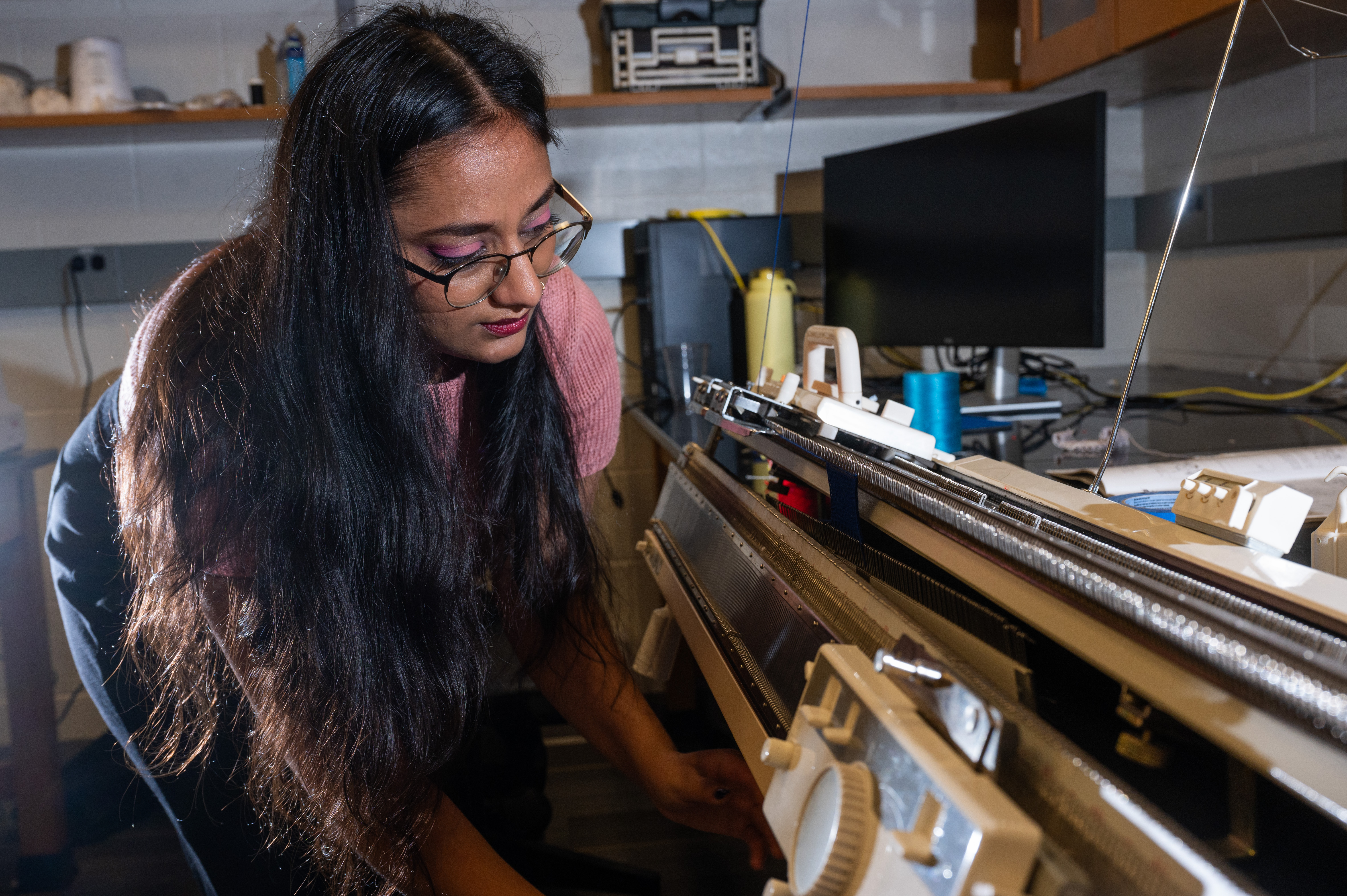School of Physics Associate Professor Elisabetta Matsumoto is unearthing the secrets of the centuries-old practice of knitting through experiments, models, and simulations. Her goal? Leveraging knitting for breakthroughs in advanced manufacturing — including more sustainable textiles, wearable electronics, and soft robotics.
Matsumoto, who is also a principal investigator at the International Institute for Sustainability with Knotted Chiral Meta Matter (WPI-SKCM2) at Hiroshima University, is the corresponding author on a new study exploring the physics of ‘jamming’ — a phenomenon when soft or stretchy materials become rigid under low stress but soften under higher tension.
The study, "Pulling Apart the Mechanisms That Lead to Jammed Knitted Fabrics," was published this week in Physical Review E, and also includes Georgia Tech Matsumoto Group graduate students Sarah Gonzalez and Alexander Cachine in addition to former postdoctoral fellow Michael Dimitriyev, who is now an assistant professor at Texas A&M University.
The work builds on the group’s previous research demonstrating that knitted materials can be mathematically ‘programmed’ to behave in predictable ways. “These properties are intuitively understood by people who knit by hand,” Matsumoto says, “but in order to manipulate and use these behaviors in an industrial setting, we need to understand the physics behind them. This new research is another step in that direction.”
An Unexpected Twist
Gonzalez, who led the research, first became interested in jamming while conducting adjacent research. “I was using model simulations to characterize how different yarn properties affect the behavior of knitted fabrics and noticed a strange stiff region,” she recalls. “In our previous research, we had also seen this behavior in lab experiments, which suggested that what we were seeing in the simulations was a genuine phenomenon. I wanted to investigate it further.”
After digging into the topic, she realized that what she was seeing was called ‘jamming.’ In knits, Gonzalez explains, jamming occurs when stitches are packed tightly together, and the fabric resists stretching. Although it’s a well-known phenomenon, the physics has mostly been investigated in granular systems, like snow or sand, rather than fabrics.
“In fabrics, when you pull softly, the response is surprisingly stiff, but when you start pulling harder and harder, the stitches rearrange, and the material softens,” Matsumoto says. “In granular systems, this is a little like how avalanches work. At low forces, the snow pack is solid, but when the slope is steep, the force of gravity liquidizes that snow pack into an avalanche.”
“In fabrics, it is a little like having a tangle in a piece of jewelry,” she adds. “If you pull on it, it gets quite stiff, but if you loosen the knot, the chain can reconfigure, and it's not so stiff.”
Unraveling the Physics of Jamming
Using a combination of experiments with industrially knitted fabrics and computer models, the team analyzed what causes jamming in fabrics and how to control it. “We wanted to determine how different yarn properties impacted jamming,” Gonzalez explains. “Our goal was to understand the mechanics of jamming through how yarn interacts at various touchpoints in stitches.”
The team found that both machine tension and yarn thickness played a key role in making a fabric more or less jammed, and that jamming behaves differently depending on which direction the fabric is stretched.
“When you stretch a knit along the rows, the stiffness of the yarn causes fabric jamming. Jamming in the other direction is due to yarn contacts,” says Gonzalez. “We also showed that the impacts of changing machine tension and yarn thickness differ depending on fabric direction.”
“Discovering that fabric jamming works differently in different directions was a key insight,” she adds. “To our knowledge, the physics of this has never been explored before.”
Modern Innovation — With a Centuries-Old Technique
The research dovetails with Matsumoto’s WPI-SKCM2 Center work, which involves investigating fundamental aspects of knots and chirality. The Center is interested in a class of materials called “knotted chiral meta matter” that could lead to more sustainable materials.
For example, knitting — which leverages chiral knots — could be used to create more elastic fabrics from natural materials. “In many cases, manufacturers use yarns that combine, for example, polyester, cotton, and elastane to create a desired elasticity,” Matsumoto says. “Our research suggests that manipulating the topology of the stitches could lead to a similar elasticity, reducing the need for petroleum-based fibers and creating a more sustainable textile.”
“Knitting has the potential to be extremely useful in manufacturing, but knowledge has typically been shared through intuition and word of mouth,” she adds. “By creating these mathematical models, we hope to formalize that knowledge in a way that’s accessible for large-scale manufacturing — so we can leverage this centuries-old intuition for modern innovation.”
Funding: This work was supported by the World Premier International Research Center Initiative (WPI), Ministry of Education, Culture, Sports, Science and Technology of Japan; National Science Foundation (NSF); and Research Corporation for Science Advancement (RCSA).



